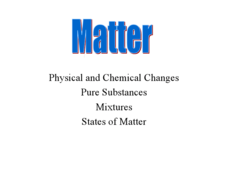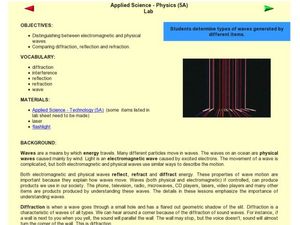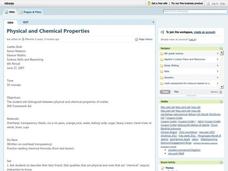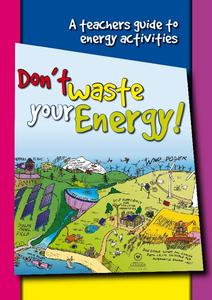Center for Learning in Action
Investigating Physical and Chemical Changes
Super scientists visit ten stations to predict, observe, and draw conclusions about the physical and chemical changes that occur when different states of matter—liquid, solid, and gas—are placed under a variety of conditions. To...
Teach Engineering
Understanding Elements
Nothing says organization quite like a table. The third instructional activity in a six-part Mixtures and Solutions unit teaches young scientists about elements and the periodic table. They learn how the periodic table is organized and...
Curated OER
Modern Physics, New Phenomena
In this physics worksheet, high schoolers examine some of the historical theories of physics through the completion of 11 questions.
Curated OER
Matter
In a neat and straightforward manner, this PowerPoint delivers basic introductory information on the properties of matter, physical and chemical changes, and pure substances vs. mixtures. It also defines the states of matter. For some...
Curated OER
Applied Science - Physics Pre-Lab
Students describe the science of physics. In this Physics lesson, students observe examples of physics within their classroom. Students create a definition for physics.
Curated OER
The Physics of Toys
Learners explore physics by experimenting with classic toys. In this physical science instructional activity, students utilize gliders, energy balls, bouncing balls, marbles and other toys to explore how they work. Learners explore each...
Curated OER
Electromagnetic and Physical Waves
Students compare and contrast electromagnetic and physical waves. In this wave lesson plan, students discover that all waves reflect, refract, and diffract energy. Students work in small groups to experiment with waves and evaluate the...
Weebly
Definitions of Conduction, Convection, and Radiation
There's quite a bit in this physical science packet. First, how is heat transferred? Learners read a brief explanation of conduction, convection, and radiation before identifying common occurrences (with pictures) as one of the three....
Curated OER
Physical and Chemical Properties
Students study the difference between physical and chemical properties. They also discuss changes in matter, known as physical and chemical changes. They observe and discuss several demonstrations of both physical and chemical changes
Government of South Australia
Don't Waste Your Energy
Don't lift another finger, this physical and environmental science unit has everything you need to begin teaching your class about energy. Starting with a look at the greenhouse effect, these lessons and activities take young scientists...
Curated OER
Physical and Chemical Changes
Young scholars observe examples of physical changes that can take place between the three states of matter and develop common sense and intuition in distinguishing between chemical and physical changes. They observe diagrams on the board...
Curated OER
The Physics of Cell Phones
Learners explain how cell phones work. In this physics lesson, students describe the advantages and advantages of having one. They identify the different parts of a cell phone.
Curated OER
Physical and Chemical Properties
In this properties worksheet, students write the correct term in the spaces beside each definition. Then, students unscramble the letters in the boxes to answer a riddle.
Curated OER
Science Puzzlers, Twisters & Teasers: The World of Physical Science
Challenge your class with these physical science puzzlers, twisters, and teasers. Each individual responds to a series of riddle-style questions that are related to scientific terminology. While this has little educational value, it...
Curated OER
Describing the Physical World
In this physical world worksheet, learners review concepts relating to the chemical and physical properties of matter, density of matter, and if matter is a solid, liquid, or gas. This worksheet has 9 terms in a word puzzle, 4 true or...
Curated OER
Exploring the Physical and Chemical Properties of Polymers
Students identify the physical and chemical properties and explore the differences. In physical and chemical property lesson students test polymers for the differences between the physical and chemical properties, record their...
Curated OER
Heat Loss and Gain in Physical Changes and Chemical Reactions
Learners measure the heat of physical and chemical changes in reactions. In this chemistry lesson plan students determine at what extent changes emit or absorb heat.
Curated OER
Playground Physics
Learners research definitions and examples of simple machines. They identify simple machines that are working parts of playground equipment that reflects their personalities and incorporates at least two simple machines. Students are...
Curated OER
Simple Machines Worksheet
Simplify students' lives with this physical science note-taking guide. From inclined planes to moveable pulleys, this resource supports young scientists with defining each type of simple machine while identifying their mechanical...
Kenan Fellows
What Is Heat?
If objects have no heat, how do they can gain and lose it? Scholars experiment with heat, temperature, and specific heat of various substances. They create definitions for these terms based on their own conclusions to complete the fourth...
Curated OER
Modern Physics, The Quantum
In this physics worksheet, students examine the relationship between the discrete and continuous spectrum alongside other concepts for the 9 questions.
Curated OER
History of Physics
In this history worksheet, learners use the questions to discover meaningful science and history connections. The worksheet is meant to be viewed online to access individual answers.
Curated OER
Families and Heredity
Personality traits and physical appearance traits within families are the focus here. Learners make a poster which lists the shared physical traits they have with their family. Peers look at each poster and write down the traits they see...
Curated OER
Over and Through Information Sheet
Eager earth scientists practice using vocabulary related to landforms and bodies of water. On the first page they categorize the terms and form sentences with them. Then, they test their knowledge with twenty-five multiple-choice...























